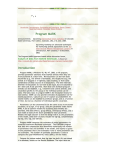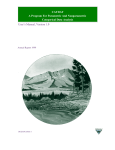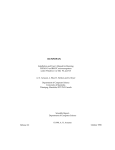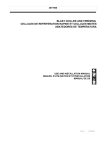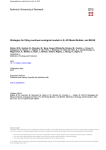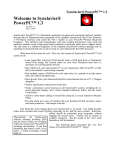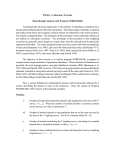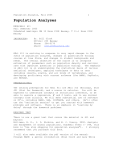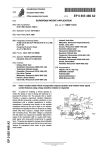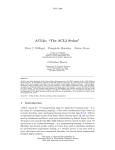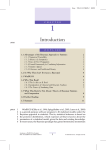Download Program MARK - Warner College of Natural Resources
Transcript
Program MARK: Survival Estimation from Populations of Marked Animals
Gary C. White, Department of Fishery and Wildlife Biology, Colorado State University, Fort
Collins, CO 80523 USA
Kenneth P. Burnham, Colorado Cooperative Fish and Wildlife Research Unit, Colorado State
University, Fort Collins, CO 80523 USA
ABSTRACT
Program MARK, a Windows 95 program, provides parameter estimates from marked animals
when they are re-encountered at a later time. Re-encounters can be from dead recoveries (e.g.,
the animal is harvested), live recaptures (e.g. the animal is re-trapped or re-sighted), radio
tracking, or from some combination of these sources of re-encounters.. The time intervals
between re-encounters do not have to be equal, but are assumed to be 1 time unit if not specified.
More than one attribute group of animals can be modeled, e.g., treatment and control animals,
and covariates specific to the group or the individual animal can be used. The basic input to
program MARK is the encounter history for each animal. MARK can also provide estimates of
population size for closed populations. Capture (p) and re-capture (c) probabilities for closed
models can be modeled by attribute groups, and as a function of time, but not as a function of
individual-specific covariates.
Parameters can be constrained to be the same across re-encounter occasions, or by age, or by
group, using the parameter index matrix (PIM). A set of common models for screening data
initially are provided, with time effects, group effects, time × group effects, and a null model of
none of the above provided for each parameter. Besides the logit function to link the design
matrix to the parameters of the model, other link functions include the log-log, complimentary
log-log, sine, log, and identity.
Program MARK computes the estimates of model parameters via numerical maximum likelihood
techniques. The FORTRAN program that does this computation also determines numerically the
number of parameters that are estimable in the model, and reports its guess of one parameter that
is not estimable if one or more parameters are not estimable. The number of estimable parameters
is used to compute the quasi-likelihood AIC value (QAICc) for the model.
Outputs for various models that the user has built (fit) are stored in a database, known as the
Results Database. The input data are also stored in this database, making it a complete
description of the model building process. The database is viewed and manipulated in a Results
Browser window.
Summaries available from the Results Browser window include viewing and printing model
output (estimates, standard errors, and goodness-of-fit tests), deviance residuals from the model
Draft October 7, 1997
Program MARK: Survival Estimation from Populations of Marked Animals
2
(including graphics and point and click capability to view the encounter history responsible for a
particular residual), likelihood ratio and analysis of deviance (ANODEV) between models, and
adjustments for over dispersion. Models can also be retrieved and modified to create additional
models.
These capabilities are implemented in a Microsoft Windows 95 interface. Context-sensitive help
screens are available with Help click buttons and the F1 key. The Shift-F1 key can also be used to
investigate the function of a particular control or menu item. Help screens include hypertext links
to other help screens, with the intent to provide all the necessary program documentation on-line
with the Help System.
INTRODUCTION
Expanding human populations and extensive habitat destruction and alteration continue to impact
the world's fauna and flora. As a result, monitoring of biological populations has begun to receive
increasing emphasis in most countries, including the less developed areas of the world (Likens
1989). Use of marked individuals and capture-recapture theory play an important role in this
process. Further, risk assessment (e.g., Burgman et al. 1993, Anderson et al. 1995) in higher
vertebrates can be done in the framework of capture-recapture theory. Population viability
analyses must rely on estimates of vital rates of a population; often these can only be derived from
the study of uniquely marked animals. The richness component of biodiversity can often be
estimated in the context of closed model capture-recapture (Burnham and Overton 1978, Nichols
and Pollock 1983). Finally, the monitoring components of adaptive management (Walters 1986)
can be rigorously addressed in terms of the analysis of data from marked subpopulations.
Capture-recapture surveys have been used as a general sampling and analysis method to assess
population status and trends in many biological populations (Burnham et al. 1996). The use of
marked individuals is analogous to the use of various tracers in studies of physiology, medicine
and nutrient cycling. Recent advances in technology allow a wide variety of marking methods
(e.g., see Parker et al. 1990).
The motivation for developing Program MARK was to bring a common programming
environment to the estimation of survival from marked animals. Marked animals can be
re-encountered as either live or dead, in a variety of experimental frameworks. Prior to MARK,
no program easily combined the estimation of survival from both live and dead re-encounters, nor
allowed for the modeling of capture and re-capture probabilities in a general modeling framework
for estimation of population size in closed populations.
The purpose of this paper is to describe the general features of Program MARK, and provide
users with a general idea of how the program operates. Documentation for the program is
provided in the Help File that is distributed with the program. Specific details for all the menu
options and dialog controls are provided in the Help File.
Draft October 7, 1997
Program MARK: Survival Estimation from Populations of Marked Animals
3
We assume the reader knows the basics about the Cormack-Jolly-Seber (Cormack 1964; Jolly
1965; Seber 1965; Pollock et al. 1990; Lebreton et al. 1992), capture-recapture (Otis et al. 1978;
White et al. 1982; Seber 1982, 1986, 1992), and recovery models (Seber 1970; Robson and
Youngs 1971; Brownie et al. 1985; Dorazio 1993), including concepts like the logit-link to
incorporate covariates into models with a design matrix (McCullagh and Nelder 1989;
Wedderburn 1974), multi-group models, model selection (Burnham and Anderson 1992) with
AIC (Akaike 1985), and maximum likelihood parameter estimation (Lebreton et al. 1992). Cooch
et al. (1996) explain many of these basics in a general primer, although the material is focused on
the SURGE program. In addition, the user must have some familiarity with the Windows 95
operating system. The objective of this paper is to describe how these methods can be used in
Program MARK.
TYPES OF ENCOUNTER DATA USED BY PROGRAM MARK
Program Mark provides parameter estimates for 5 types of re-encounter data: (1) Cormack-JollySeber models (live animal recaptures that are released alive), (2) band or ring recovery models
(dead animal recoveries), (3) models with both live and dead re-encounters, (4) known fate (e.g.,
radio-tracking) models, and (5) some closed capture-recapture models.
Live Recaptures. Live recaptures are the basis of the standard Cormack-Jolly-Seber (CJS)
model. Marked animals are released into the population, usually by trapping them from the
population. Then, marked animals are encountered by catching them alive and re-releasing them,
or often just a visual resighting. If marked animals are released into the population on occasion 1,
then each succeeding capture occasion is one encounter occasion. Consider the following
scenario:
Encounter History
Seen
11 φ p
Not Seen
10 φ ( 1 − p )
p
φ
Releases
1− φ
Live
1− p
Dead or
Emigrated
Draft October 7, 1997
10 1− φ
Program MARK: Survival Estimation from Populations of Marked Animals
4
Animals survive from initial release to the second encounter with probability S1 , from the second
encounter occasion to the third encounter occasion with probability S2 , etc. The recapture
probability at encounter occasion 2 is p2 , p3 is the recapture probability at encounter occasion 3,
etc. At least 2 re-encounter occasions are required to estimate the survival probability ( S1 )
between the first release occasion and the next encounter occasion in the full time-effects model.
The survival probability between the last two encounter occasions is not estimable in the full timeeffects model because only the product of survival and recapture probability for this occasion is
identifiable.
Generally, as in the figure, the conditional survival probabilities of the CJS model are labeled as
φ1 , φ 2 , etc., because the quantity estimated is the probability of remaining available for recapture.
Thus, animals that emigrate from the study area are not available for recapture, so appear to have
died in this model. Thus, φi = Si (1 − Ei ) , where Ei is the probability of emigrating from the
study area, and φi is termed 'apparent' survival, as this parameter is technically not the survival
probability of marked animals in the population. Rather, φi is the probability that the animal
remains alive and is available for recapture.
Estimates of population size ( N̂ ) or births and immigration ( B̂ ) of the Jolly-Seber model are not
provided in Program MARK, as in POPAN-4 (Arnason and Schwarz 1995, Schwarz and Arnason
1996) or JOLLY and JOLLYAGE (Pollock et al. 1990).
Dead Recoveries. With dead recoveries (i.e., band, fish tag, or ring recovery models), animals
are captured from the population, marked, and released back into the population at each
occasion. Later, marked animals are encountered as dead animals, typically from harvest or just
found dead (e.g., gulls). The following diagram illustrates this scenario:
Encounter History
S
Releases
1-S
10 S
Live
r
Reported
11 (1 - S)r
Not
Reported
10 (1 - S)(1 - r)
Dead
1-r
Draft October 7, 1997
Program MARK: Survival Estimation from Populations of Marked Animals
5
Marked animals are assumed to survive from one release to the next with survival probability Si .
If they die, the dead marked animals are reported during each period between releases with
probability ri . The survival probability and reporting probability prior to the last release can not
be estimated individually in the full time-effects model, but only as a product. This
parameterization differs from that of Brownie et al. (1985) in that their f i is replaced as
f i = (1 − Si )ri . The ri are equivalent to the λi of life table models (Anderson et al. 1985;
Catchpole et al. 1995). The reason for making this change is so that the encounter process,
modeled with the ri parameters, can be separated from the survival process, modeled with the Si
parameters. With the f i parameterization, the 2 processes are both part of this parameter. Hence,
developing more advanced models with the design matrix options of MARK is difficult, if not
illogical with the f i parameterization. However, the negative side of this new parameterization is
that the last Si and ri are confounded in the full time-effects model, as only the product
(1− Si ) ri is identifiable, and hence estimable.
Both Live and Dead Encounters. The model for the joint live and dead encounter data type was
first published by Burnham (1993), but with a slightly different parameterization than used in
Program MARK. In MARK, the dead encounters are not modeled with the f i of Burnham
(1993), but rather as f i = (1 − Si )ri , as discussed above for the dead encounter models. The
method is a combination of the 2 above, but allows the estimation of fidelity ( Fi = 1 − Ei ), or the
probability that the animal remains on the study area and is available for capture. As a result, the
estimates of Si are estimates of the survival probability of the marked animals, and not the
apparent survival ( φi = Si Fi ) as discussed for the live encounter model.
In the models discussed so far, live captures and resightings modeled with the pi parameters are
assumed to occur over a short time interval, whereas dead recoveries modeled with the ri
parameters extend over the time interval. The actual time of the dead recovery is not used in the
estimation of survival for 2 reasons. First, it is often not known. Second, even if the exact time
of recovery is known, little information is contributed if the recovery probability ( ri ) is varying
during the time interval.
Known Fates. Known fate data assumes that there are no nuisance parameters involved with
animal captures or resightings. The data derive from radio-tracking studies, although some radiotracking studies fail to follow all the marked animals and so would not meet the assumptions of
this model. A diagram illustrating this scenario is
S1
Release
S2
Encounter 2
S3
Encounter 3
Encounter 4 ...
where the probability of encounter on each occasion is 1 if the animal is alive.
Draft October 7, 1997
Program MARK: Survival Estimation from Populations of Marked Animals
6
Closed Captures. Closed-capture data assume that all survival probabilities are 1.0 across the
short time intervals of the study. Thus, survival is not estimated. Rather, the probability of first
capture ( pi ) and the probability of recapture ( ci ) are estimated, along with the number of animals
in the population ( Ni ). The diagram describing this scenario looks like the following:
Occasion 1
p1
Occasion 2
p2
c2
Occasion 3
p3
c3
Occasion 4 ...
p4 First Encounter
c4 Additional Encounter(s)
where the ci recapture probability parameters are shown under the initial capture ( pi )
parameters. This data type is the same as is analyzed with Program CAPTURE (White et al.
1982). All the likelihood models in CAPTURE can be duplicated in MARK. However, MARK
allows additional models not available in CAPTURE, plus comparisons between groups and the
incorporation of time-specific and/or group-specific covariates into the model.
The main limitation of MARK for closed capture-recapture models is the lack of models
incorporating individual heterogeneity. Individual covariates cannot be used with this data type
because existing models in the literature (Huggins 1989, 1991; Alho 1990) have not yet been
implemented.
Other Models. Models for other types of encounter data are also available in Program MARK,
including the robust design model (Kendal et al. 1995, Kendall and Nichols 1995, Kendall et al.
1997), multi-strata model (Hestbeck et al. 1991, Brownie et al. 1993), Barker’s (1997) extension
to the joint live and dead encounters model, ring recovery models where the number of birds
marked is unknown, and the Brownie et al. (1985) parameterization of ring recovery models.
PROGRAM OPERATION
Program MARK is operated by a Windows 95 interface. A "batch " file mode of operation is
available in that the numerical procedure reads an ASCII input file. However, models are
constructed interactively with the interface much easier than creating them manually in an ASCII
input file. Interactive and context-sensitive help is available at any time while working in the
interface program. The Help System is constructed with the Windows Help System, so is likely
familiar to most users. No printed documentation on MARK (other than this manuscript) is
provided; all documentation is contained in the Help System, thus insuring that the documentation
is current with the current version of the program.
All analyses in MARK are based on encounter histories. To begin construction of a set of models
for a data set, the data must first be read by MARK from the Encounter Histories file. Next, the
Parameter Index Matrices (PIM) can be manipulated, followed by the Design Matrix. These tools
provide the model specifications to construct a broad array of models. Once the model is fully
specified, the Run Window is opened, where the link function is specified and currently must be
Draft October 7, 1997
Program MARK: Survival Estimation from Populations of Marked Animals
7
the same for all parameters, parameters can be "fixed " to specific values, and the name of the
model is specified. Once a set of models has been constructed, likelihood ratio tests between
models can be computed, or Analysis of Deviance (ANODEV) tables constructed.
To begin an analysis, you must create an Encounter Histories file using an ASCII text editor, such
as the NotePad or WordPad editors that are provided within Windows 95. The format of the
Encounter Histories file is similar to Program RELEASE (Burnham et al. 1987), and is identical
for live recapture data without covariates. MARK does not provide data management capabilities
for the encounter histories. Once the Encounter Histories file is created, start Program MARK
and select File, New. The dialog box shown in Fig. 1 appears.
Figure 1. Dialog box requesting the information to begin an analysis.
As shown in the middle of Fig. 1, you are requested to enter the number of encounter occasions,
number of groups (e.g., sex, ages, areas), number of individual covariates, and only if the multistrata model was selected, the number of strata.. Each of these variables can have additional
input, accomplished by clicking the push button next to the input box. On the left side, you
specify the type of data. Just to the right, you specify the title for the data, and the name of the
Encounter Histories file, with a push button to help you find the file, plus a second push button
the examine the contents of the file once you have selected it. At the bottom of the screen is the
OK button to proceed once you have entered the necessary information, a Cancel button to quit,
and a Help button to obtain help from the help file. You can also hit the Shift-F1 key when any of
Draft October 7, 1997
Program MARK: Survival Estimation from Populations of Marked Animals
8
the controls on the window are highlighted to obtain context-sensitive help for that specific
control.
Encounter Histories File. To provide the data for parameter estimation, the Encounter Histories
file is used. This file contains the encounter histories, i.e., the raw data needed by Program
MARK. Format of the file depends on the data type, although all data types allow a conceptually
similar encounter history format. The convention of Program Mark is that this file name ends in
the INP suffix. The root part of an Encounter Histories file name dictates the name of the dBASE
file used to hold model results. For example, the input file MULEDEER.INP would produce a
Results file with the name MULEDEER.DBF and 2 additional files (MULEDEER.FPT and
MULEDEER.CDX) that would contain the memo fields holding model output and index ordering,
respectively. Once the DBF, FPT, and CDX files are created, the INP file is no longer needed. Its
contents are now part of the DBF file.
Encounter Histories files do not contain any PROC statements (as in Program RELEASE), but
only encounter histories or recovery matrices. You can have group label statements and comment
statements in the input file, just to help you remember what the file contains. Remember to end
these statements with a semicolon. The interactive interface adds the necessary program
statements to produce parameter estimates with the numerical algorithm based on the model
specified.
The Encounter Histories file is incorporated into the results database created to hold parameter
estimates and other results. Because all results in the results database depend on the encounter
histories not changing, you cannot change the input. Even if you change the values in the
Encounter Histories file, the Results file will not change. The only way to produce models from a
changed Encounter Histories file is to incorporate the changed file into a new results database
(hence, start over). You can view the encounter histories in the results database by having it
listed in the results for a model by checking the list data checkbox in the Run Window.
Some simplified examples of Encounter Histories files follow. The full set of data for each
example is provided in the Program MARK help file, and as an example input file distributed with
the program.
First is a live recapture data set with 2 groups and 6 encounter occasions. Note that the release
occasion is counted as an encounter occasion (in contrast to the protocol used in Program
SURGE). The encounter history is coded for just the live encounters, i.e.,
LLLLLL
and the initial capture is counted as an encounter occasion. Again, the encounter histories are
given, with 1 indicating a live capture or recapture, and 0 meaning not captured. The number of
Draft October 7, 1997
Program MARK: Survival Estimation from Populations of Marked Animals
9
animals in each group follows the encounter history. Negative values indicate animals that were
not released again, i.e., losses on capture. The following example is the partial input for the
example data in Burnham et al. (1987:29). As you might expect, any input file used with Program
RELEASE will work with MARK if the RELEASE-specific PROC statements are removed.
100000 25925
100001 563
100001 -27
...
110100 67
110100 -3
110101 1
110110 2
111000 10
111001 0
111100 1
24605;
605;
-36;
68;
-4;
2;
1;
12;
1;
0;
Next, a joint live recapture and dead recovery encounter histories file is shown, with only one
group, but 5 encounter occasions. The encounter histories are alternating live (L) recaptures and
dead (D) recoveries, i.e.,
LDLDLDLDLD
with 1 indicating a recapture or recovery, and 0 indicating no encounter. Encounter histories
always start with an L and end with a D in Program MARK. The number after the encounter
history is the number of animals with this history for group 1, just as with Program RELEASE.
Following the frequency for the last group, a semi-colon is used to end the statement. Note that a
common mistake is to not end statements with semicolons.
1000000000
1000000001
1000000010
1000000011
1000000100
...
1010101010
1010101011
1010101100
1010110000
1011000000
1100000000
41152;
1923;
557;
103;
2897;
184;
24;
144;
583;
2672;
15153;
The next example is the summarized input for a dead recovery data set with 15 release occasions
and 15 years of recovery data. Even though the raw data are read as recovery matrices,
encounter histories are created internally in MARK. The triangular matrices represent 2 groups;
adults, followed by young. Following each upper-triangular matrix is the number of animals
marked and released into the population each year. This format is similar to that used by Brownie
et al. (1985). The input lines identified with the phrase "recovery matrix" are required to identify
the input as a recovery matrix, and are not interpreted as an encounter history.
Draft October 7, 1997
Program MARK: Survival Estimation from Populations of Marked Animals
recovery matrix group=1;
7
4
1
0
1
8
5
1
0
10
4
2
16
3
12
0
0
0
2
3
10
0
0
1
0
2
9
14
0
0
1
0
3
3
9
9
0
0
0
0
0
0
3
5
16
0
0
0
0
0
0
3
2
5
19
0
0
0
0
0
0
0
1
2
6
15
0
0
0
0
0
0
0
0
0
2
3
8
0
0
0
0
0
0
0
1
1
1
0
5
10
0
0
0
0
0
0
0
0
0
0
0
1
1
8
99
88
153
114
123
recovery matrix group=2;
6
4
6
1
0
6
5
2
1
18
6
6
17
5
20
98
146
173
190
190
157
92
88
51
1
0
2
6
9
14
0
0
0
2
6
4
13
0
0
1
1
2
3
4
13
0
0
0
1
1
1
0
5
13
0
0
0
0
1
0
1
3
5
7
0
0
0
0
0
0
0
1
4
1
15
0
0
0
0
0
0
0
0
0
3
10
12
0
0
0
0
0
0
0
0
0
1
2
4
16
0
0
0
0
0
0
0
0
0
1
0
0
4
5
80
106
111
127
110
110
152
102
163
104
54
138
120
183
10
0;
0;
0;
0;
0;
0;
0;
0;
0;
1;
0;
0;
0;
1;
10;
85;
0;
0;
0;
0;
0;
0;
0;
0;
0;
0;
0;
0;
1;
2;
8;
117;
No automatic capability to handle non-triangular recovery matrices has been included in MARK.
Non-triangular matrices are generated when marking new animals ceases, but recoveries are
continued. Such data sets can be handled by forming a triangular recovery matrix with the
additions of zeros for the number banded and recovered. During analysis, the parameters
associated with these zero data should be fixed to logical values (i.e., ri = 0) to reduce numerical
problems with non-estimable parameters.
Dead recoveries can also be coded as encounter histories in the
LDLDLDLDLDLD
format. The following is an example of only dead recoveries, because a live animal is never
captured alive after its initial capture. That is, none of the encounter histories have more than a
single 1 in an L column. This example has 15 encounter occasions and 1 group.
Draft October 7, 1997
Program MARK: Survival Estimation from Populations of Marked Animals
000000000000000000000000000010
000000000000000000000000000011
000000000000000000000000001000
000000000000000000000000001001
000000000000000000000000001100
...
100000010000000000000000000000
100001000000000000000000000000
100100000000000000000000000000
110000000000000000000000000000
11
465;
35;
418;
15;
67;
11;
9;
51;
33;
The next example is the input for a data set with known fates. As with dead recovery matrices,
the summarized input is used to create encounter histories. Each line presents the number of
animals monitored for one time interval, in this case, a week. The first value is the number of
animals monitored, followed by the number that died during the interval. Each group is provided
in a separate matrix. In the following example, a group of black ducks are monitored for 8 weeks
(Conroy et al. 1989). Initially, 48 ducks were monitored, and 1 died during the first week. The
remaining 47 ducks were monitored during the second week, when 2 died. However, 4 more
were lost from the study for other reasons, i.e., resulting in a reduction in the numbers of animals
monitored. As a result, only 41 ducks were available for monitoring during the third week. The
phrase "known fate" on the first line of input is required to identify the input as this special format,
instead of the usual encounter history format.
known fate
48
47
41
39
32
28
25
24
group=1;
1;
2;
2;
5;
4;
3;
1;
0;
The following input is an example of a closed capture-recapture data set. The capture histories
are specified as a single 1 or 0 for each occasion, representing captured (1) or not captured (0).
Following the capture history is the frequency, or count of the number of animals with this
capture history, for each group. In the example, 2 groups are provided. Individual covariates are
not allowed with closed captures, because the models of Huggins (1989, 1991) and Albo (1990)
have not been implemented. This data set could have been stored more compactly by not
representing each animal on a separate line of input. The advantage of entering the data as shown
with only a 0 or 1 as the capture frequency is that the input file can also be used with Program
CAPTURE.
0101010
0011000
1001100
1100101
...
1000101
0100000
1010100
1001010
1
1
1
1
0;
0;
0;
0;
0
0
0
0
1;
1;
1;
1;
Draft October 7, 1997
Program MARK: Survival Estimation from Populations of Marked Animals
12
Additional examples of encounter history files are provided in the help document distributed with
the program.
Parameter Index Matrices. The Parameter Index Matrices (PIM), allow constraints to be
placed on the parameter estimates. There is a parameter matrix for each type of basic parameter
in each group model, with each parameter matrix shown in its own window. As an example
suppose that 2 groups of animals are marked. Then, for live recaptures, 2 Apparent Survival ( φ )
matrices (Windows) would be displayed, and 2 Recapture Probability (p) matrices (Windows)
would be shown. Likewise, for dead recovery data for 2 groups, 2 Survival (S) matrices and 2
reporting probability (r) matrices would be used, for 4 windows. When both live and dead
recoveries are modeled, each group would have 4 parameters types: S, r, p, and F. Thus, 8
windows would be available. Only the first window is opened by default. Any (or all) of the PIM
windows can be opened from the PIM menu option. Likewise, any PIM window that is currently
open can be closed, and later opened again.
The parameter index matrices determine the number of basic parameters that will be estimated
(i.e., the number of rows in the design matrix), and hence, the PIM must be constructed before
use of the Design Matrix window. PIMs may reduce the number of basic parameters, with further
constraints provided by the design matrix. Commands are available to set all the parameter
matrices to a particular format (e.g., all constant, all time-specific, or all age-specific), or to set
the current window to a particular format.
Included on the PIM window are push buttons to Close the window (but the values of parameter
settings are not lost; they just are not displayed), Help to display this help screen, PIM Chart to
graphically display the relationship among the PIM values, and + and - to increment or decrement,
respectively, all the index values in the PIM Window by 1.
Parameter matrices can be manipulated to specify various models. The following are the
parameter matrices for live recapture data to specify a { φ (g*t) p(g*t)} model for a data set with
5 encounter occasions (resulting in 4 survival intervals and 4 recapture occasions) and 2 groups.
Draft October 7, 1997
Program MARK: Survival Estimation from Populations of Marked Animals
13
Apparent Survival Group 1
1
2
3
4
2
3
4
3
4
4
Apparent Survival Group 2
5
6
6
7
7
7
8
8
8
8
Recapture Probabilities Group 1
9
10
11
12
10
11
12
11
12
12
Recapture Probabilities Group 2
13
14
15
16
14
15
16
15
16
16
In this example, parameter 1 is apparent survival for the first interval for group 1, and parameter 2
is apparent survival for the second interval for group 1. Parameter 7 is apparent survival for the
third interval for group 2, and parameter 8 is apparent survival for the fourth interval for group 2.
Parameter 9 is the recapture probability for the second occasion for group 1, parameter 10 is the
recapture probability for the third occasion for group 1. Parameter 15 is the recapture probability
for the fourth occasion for group 2, and parameter 16 is the recapture probability for the fifth
occasion for group 2. Note that the capture probability for the first occasion is not estimated
under the Cormack-Jolly-Seber model, and thus does not appear in the parameter index matrices
for recapture probabilities.
To reduce this model to { φ (t) p(t)}, the following parameter matrices would work.
Apparent Survival Group 1
1
2
3
4
2
3
4
3
4
4
Apparent Survival Group 2
1
2
3
4
2
3
4
3
4
4
Recapture Probabilities Group 1
5
6
7
8
6
7
8
7
8
8
Recapture Probabilities Group 2
5
6
7
8
6
7
8
7
8
8
Draft October 7, 1997
Program MARK: Survival Estimation from Populations of Marked Animals
14
In the above example, the parameters are constrained equal across groups.
The following parameter matrices have no time effect, but do have a group effect. Thus, the
model is { φ (g) p(g)}.
Apparent Survival Group 1
1
1
1
1
1
1
1
1
1
1
Apparent Survival Group 2
2
2
2
2
2
2
2
2
2
2
Recapture Probabilities Group 1
3
3
3
3
3
3
3
3
3
3
Recapture Probabilities Group 2
4
4
4
4
4
4
4
4
4
4
Additional examples of PIMs demonstrating age and cohort models are provided with the Help
system that accompanies the program. Also Cooch et al. (1996) provide many more examples of
how to structure the parameter indices.
The Parameter Index Chart displays graphically the relationship of parameters across the attribute
groups and time (Fig. 2).
Draft October 7, 1997
Program MARK: Survival Estimation from Populations of Marked Animals
15
Figure 2 . Example of a Parameter Index Chart depicting the { φ (t) p(g)} model for liverecapture (CJS) data with 5 encounter occasions (resulting in 4 survival intervals) and 2 attribute
groups. This chart allows you to verify the parameter indices without manually checking each
PIM Window.
The concept of a PIM derives from program SURGE (Pradel and Lebreton 1993, Lebreton et al.
1992), with graphical manipulation of the PIM first demonstrated by Program SURPH (Smith et
al. 1994). However, a key difference in the implementation in MARK from SURGE is that the
PIMs can allow overlap of parameter indices across parameters types, and thus the same
parameter estimate could be used for both a φ and a p. Although such a model is unlikely for
just live recaptures or dead recoveries, we can visualize such models with joint live and dead
encounters.
Design Matrix. Additional constraints can be placed on parameters with the Design Matrix. The
concept of a design matrix comes from general linear models (GLM) (McCullagh and Nelder
1989). The design matrix ( X ) is multiplied by the parameter vector ( β ) to produce the original
parameters ( φ , S , p, r , etc.) via a link function. For instance,
logit(θ ) = X β
Draft October 7, 1997
Program MARK: Survival Estimation from Populations of Marked Animals
16
uses the logit link function to link the design matrix to the vector of original parameters ( θ ). The
elements of θ are the original parameters, whereas the columns of matrix X correspond to the
reduced parameter vector β .
Assume that the PIM model is { φ (g*t) p(g*t)} as shown in the text above for 5 encounter
occasions. To specify the fully additive { φ (g+t) p(g+t)} model where paramters vary temporally
in parallel, the design matrix must be used. The design matrix is opened with the Design menu
option. The design matrix always has the same number of rows as there are parameters in the
PIMs. However, the number of columns can be variable. A choice of Full or Reduced is offered
when the Design menu option is selected. The Full Design Matrix has the same number of
columns as rows and defaults to an identity matrix, whereas the Reduced Design Matrix allows
you to specify the number of columns and is initialized to all zeros. Each parameter specified in
the PIMs will now be computed as a linear combination of the columns of the design matrix.
Each parameter in the PIMs has its own row in the design matrix. Thus, the design matrix
provides a set of constraints on the parameters in the PIMs by reducing the number of parameters
(number of rows) from the number of unique values in the PIMs to the number of columns in the
design matrix.
The concept of a design matrix for use with capture-recapture data was taken from Program
SURGE (Pradel and Lebreton 1993). However, in MARK a single design matrix applies to all
parameters, unlike SURGE where design matrices are specific to a parameter type, i.e., either
apparent survival or recapture probability. The more general implementation in MARK allows
parameters of different types to be modeled by the same function of 1 or more covariates. As an
example, parallelism could be enforced between live recapture and dead recovery probabilities, or
between survival and fidelity. Also, unlike SURGE, MARK does not assume an intercept in the
design matrix. If no design matrix is specified, the default is an identity matrix, where each
parameter in the PIMs corresponds to a column in the design matrix.
The following is an example of a design matrix for the additive { φ (g+t) p(g+t)} model used to
demonstrate various PIMs with 5 encounter occasions. In this model, the time effect is the same
for each group, with the group effect additive to this time effect. In the following matrix, column
1 is the group effect for apparent survival, columns 2-5 are the time effects for apparent survival,
column 6 is the group effect for recapture probabilities, and columns 7-10 are the time effects for
the recapture probabilities. The first 4 rows correspond to the φ for group 1, the next 4 rows for
φ for group 2, the next 4 rows for pi for group 1, and the last 4 rows for pi for group 2. Note
that the group effect is zero for the first group, and 1 for the second group.
Draft October 7, 1997
Program MARK: Survival Estimation from Populations of Marked Animals
0
0
0
0
1
1
1
1
0
0
0
0
0
0
0
0
1
0
0
0
1
0
0
0
0
0
0
0
0
0
0
0
0
1
0
0
0
1
0
0
0
0
0
0
0
0
0
0
0
0
1
0
0
0
1
0
0
0
0
0
0
0
0
0
0
0
0
1
0
0
0
1
0
0
0
0
0
0
0
0
0
0
0
0
0
0
0
0
0
0
0
0
1
1
1
1
0
0
0
0
0
0
0
0
1
0
0
0
1
0
0
0
0
0
0
0
0
0
0
0
0
1
0
0
0
1
0
0
0
0
0
0
0
0
0
0
0
0
1
0
0
0
1
0
17
0
0
0
0
0
0
0
0
0
0
0
1
0
0
0
1
The Design Matrix can also be used to provide additional information from time-varying
covariates. As an example, suppose the rainfall for the 4 survival intervals in the above example is
2, 10, 4, and 3 cm. This information could be used to model survival effects with the following
model, where each group has a different intercept for survival, but a common slope. The model
name would be { φ (g+rainfall) p(g+t)}. Column 1 is the intercept for group 1, column 2 is the
offset of the intercept for group 2, and column 3 is the rainfall variable.
1
1
1
1
1
1
1
1
0
0
0
0
0
0
0
0
0
0
0
0
1
1
1
1
0
0
0
0
0
0
0
0
2
10
4
3
2
10
4
3
0
0
0
0
0
0
0
0
0
0
0
0
0
0
0
0
0
0
0
0
1
1
1
1
0
0
0
0
0
0
0
0
1
0
0
0
1
0
0
0
0
0
0
0
0
0
0
0
0
1
0
0
0
1
0
0
0
0
0
0
0
0
0
0
0
0
1
0
0
0
1
0
0
0
0
0
0
0
0
0
0
0
0
1
0
0
0
1
A similar Design Matrix could be used to evaluate differences in the trend of survival for the 2
groups. The rainfall covariate in column 3 has been replaced by a time trend variable, resulting in
a covariance analysis on the φ 's: parallel regressions with different intercepts..
Draft October 7, 1997
Program MARK: Survival Estimation from Populations of Marked Animals
1
1
1
1
1
1
1
1
0
0
0
0
0
0
0
0
0
0
0
0
1
1
1
1
0
0
0
0
0
0
0
0
1
2
3
4
1
2
3
4
0
0
0
0
0
0
0
0
0
0
0
0
0
0
0
0
0
0
0
0
1
1
1
1
0
0
0
0
0
0
0
0
1
0
0
0
1
0
0
0
0
0
0
0
0
0
0
0
0
1
0
0
0
1
0
0
0
0
0
0
0
0
0
0
0
0
1
0
0
0
1
0
18
0
0
0
0
0
0
0
0
0
0
0
1
0
0
0
1
Individual covariates are also incorporated into an analysis via the design matrix. By specifying
the name of an individual covariate in a cell of the Design Matrix, you tell MARK to use the
value of this covariate in the design matrix when the capture history for this individual is used in
the likelihood. As an example, suppose that 2 individual covariates are included: age (0=subadult,
1=adult), and weight at time of initial capture. The variable names given to these variables are,
naturally, AGE and WEIGHT. These names were assigned in the dialog box where the encounter
histories file was specified (Figure 1). The following design matrix would use weight as a
covariate, with an intercept term and a group effect. The model name would be { φ (g+weight)
p(g+t)}.
1
1
1
1
1
1
1
1
0
0
0
0
0
0
0
0
0
0
0
0
1
1
1
1
0
0
0
0
0
0
0
0
weight
weight
weight
weight
weight
weight
weight
weight
0
0
0
0
0
0
0
0
0
0
0
0
0
0
0
0
0
0
0
0
1
1
1
1
0
0
0
0
0
0
0
0
1
0
0
0
1
0
0
0
0
0
0
0
0
0
0
0
0
1
0
0
0
1
0
0
0
0
0
0
0
0
0
0
0
0
1
0
0
0
1
0
0
0
0
0
0
0
0
0
0
0
0
1
0
0
0
1
Each of the 8 apparent survival probabilities would be modeled with the same slope parameter for
WEIGHT, but on an individual animal basis. Thus, time is not included in the relationship.
However, a group effect is included in survival, so that each group would have a different
intercept. Suppose you believe that the relationship between survival and weight changes with
each time interval. The following design matrix would allow 4 different weight models, one for
each survival occasion. The model would be named { φ (g+t*weight) p(g+t)}.
Draft October 7, 1997
Program MARK: Survival Estimation from Populations of Marked Animals
1
1
1
1
1
1
1
1
0
0
0
0
0
0
0
0
0
0
0
0
1
1
1
1
0
0
0
0
0
0
0
0
weight
0
0
0
weight
0
0
0
0
0
0
0
0
0
0
0
0
weight
0
0
0
weight
0
0
0
0
0
0
0
0
0
0
0
0
weight
0
0
0
weight
0
0
0
0
0
0
0
0
0
0
0
0
weight
0
0
0
weight
0
0
0
0
0
0
0
0
0
0
0
0
0
0
0
0
0
0
0
0
1
1
1
1
0
0
0
0
0
0
0
0
1
0
0
0
1
0
0
0
0
0
0
0
0
0
0
0
0
1
0
0
0
1
0
0
19
0
0
0
0
0
0
0
0
0
0
1
0
0
0
1
0
0
0
0
0
0
0
0
0
0
0
0
1
0
0
0
1
Many more examples of how to construct the design matrix are provided in the Program MARK
interactive Help System. Numerous menu options are described in the Help System to avoid
having to build a design matrix manually, e.g., to fill 1 or more columns with various designs.
Run Window. The Run Window is opened by selecting the Run menu option. This window
(Fig. 3) allows you to specify the Run Title, Model Name, parameters to Fix to a specified value,
the Link Function to be used, and the Variance Estimation algorithm to be used. You can also
select various program options such as whether to list the raw data (encounter histories) and/or
variance-covariance matrices in the output, plus other program options that concern the numerical
optimization of the likelihood function to obtain parameter estimates.
Figure 3. Example of the Run Window for Program MARK.
The Title entry box allows you to modify the title printed on output for a set of data. Normally,
you will set this for the first model for which you estimate parameters, and then not change it.
Draft October 7, 1997
Program MARK: Survival Estimation from Populations of Marked Animals
20
The Model Name entry box is where a name for the model you have specified with the PIMs and
Design Matrix is specified. Various model naming conventions have developed in the literature,
but we prefer something patterned after the procedure of Lebreton et al. (1992), as demonstrated
elsewhere in the paper. The main idea is to provide enough detail in the model name entry so that
you can easily determine the model's structure and what parameters were estimated based on the
model name.
Fixing Parameters. By selecting the Fix Parameters Button on the Run Window screen, you can
select parameters to "fix", hence cause them to not be estimated. A dialog window listing all the
parameters is presented, with edit boxes to enter the value that you want the parameter to be fixed
at. By fixing a parameter, you are saying that you do not want this parameter to be estimated
from the data, but rather set to the specified value. Fixing a parameter is a useful method to
determine if it is confounded with another parameter. For example, the last φ and p are
confounded in the time-specific Cormack-Jolly-Seber model, as are the last S and r in the
time-specific dead recoveries model. You can set the last p or r to 1.0 to force the survival
parameter to be estimated as the product.
Link Functions. A link function links the linear model specified in the design matrix with the
survival, recapture, reporting, and fidelity parameters specified in the PIMs. Program Mark
supports 6 different link functions. The default is the sin function because it is generally more
computationally efficient for parameter estimation. For the sin link function, the linear
combination from the design matrix ( X β , where β is the vector of parameters and X is the
design matrix) is converted to the interval [0,1] by the link function
parameter value = (sin( X β ) + 1)/2 .
Other link functions include the logit,
parameter value = exp( X β )/[1 + exp( X β )] ,
the loglog,
parameter value = exp[-exp( X β )] ,
the complimentary loglog,
parameter value = 1 - exp[-exp( X β )] ,
the log,
parameter value = exp( X β ), and
the identity,
parameter value = X β .
The last two (log and identity) link functions do not constrain the parameter value to the interval
[0, 1], so can cause numerical problems when optimizing the likelihood. Program MARK uses
the sin link function to obtain initial estimates for parameters, then transforms the estimates to the
Draft October 7, 1997
Program MARK: Survival Estimation from Populations of Marked Animals
21
parameter space of the log or identity link functions and then re-optimizes the likelihood function
when those link functions are requested.
The sin link should only be used with design matrices that contain a single 1 in each row such as
an identity matrix. The identity matrix is the default when no design matrix is specified. The sin
link will reflect around the parameter boundary, and not enforce monotonic relationships, when
multiple 1's occur in a single row or covariates are used. The logit link is better for non-identity
design matrices. The sin link is the best link function to enforce parameter values in the [0, 1]
interval and yet obtain correct estimates of the number of parameters estimated, mainly because
the parameter value does reflect around the interval boundary. In contrast, the logit link allows
the parameter value to asymptotically approach the boundary, which can cause numerical
problems and suggest that the parameter is not estimable.
The identity link is the best link function for determining the number of parameters estimated
when the [0, 1] interval does not need to be enforced because no parameter is at a boundary that
may be confused with the parameter not being estimable. The MLE of p must, and is, always in
[0, 1] even with an identity link. However, φ or S can mathematically exceed 1 yet the
likelihood is computable. So the exact MLE of φ , or S , can exceed 1. The mathematics of the
model do not know there is an interpretation on these parameters that says they must all be in
[0, 1]. It is also mathematically possible for the MLE of r or F to occur as greater than 1. It is
only required that the multinomial cell probabilities in the likelihood stay in the interval [0, 1].
When they do not, then the program has computational problems. With too general of a model
(i.e., more parameters than supported by the available data), it is common that the exact MLE will
) ) )
occur with some φ , S , F > 1 (but this result depends on which basic model is used).
Variance Estimation. Four different procedures are provided in MARK to estimate the
variance-covariance matrix of the estimates. The first (option Hessian) is the inverse of the
Hessian matrix obtained as part of the numerical optimization of the likelihood function. This
approach is not reliable in that the resulting variance-covariance matrix is not particularly close to
the true variance-covariance matrix, and should only be used with you are not interested in the
standard errors, and already know the number of parameters that were estimated. The only
reason for including this method in the program is that it is the fastest; no additional computation
to compute the information matrix is required for this method.
The second method (option Observed) computes the information matrix (matrix of second partials
of the likelihood function) by computing the numerical derivatives of the probabilities of each
capture history, known as the cell probabilities. The information matrix is computed as the sum
across capture histories of the partial of cell i times the partial of cell j times the observed cell
frequency divided by the cell probability squared. Because the observed cell frequency is used in
place of the expected cell frequency, the label for this method is observed. This method cannot be
Draft October 7, 1997
Program MARK: Survival Estimation from Populations of Marked Animals
22
used with closed capture data, because the likelihood involves more than just the capture history
cell probabilities.
The third method (option Expected) is much the same as the observed method, but instead of
using the observed cell frequency, the expected value (equal to the size of the cohort times the
estimated cell probability) is used instead. This method generally overestimates the variances of
the parameters because information is lost from pooling all of the unobserved cells, i.e., all the
capture histories that were never observed are pooled into one cell. This method cannot be used
with closed capture data, because the likelihood involves more than just the capture history cell
probabilities.
The fourth method (option 2ndPart.) computes the information matrix directly using central
difference approximations. This method provides the most accurate estimates of the standard
errors, and is the default and preferred method. However, this method requires the most
computation because the likelihood function has to be evaluated for a large set of parameter
values to compute the numerical derivatives. Hence, this method is the slowest.
Because the rank of the variance-covariance matrix is used to determine the number of parameters
that were actually estimated, using different methods will sometimes result in a different number
of parameters estimated, and hence a different value of the QAICc.
Estimation Options. On the right side of the Run Window, options concerning the numerical
optimization procedure can be specified. Specifically, “Provide initial parameter estimates” allows
the user to specify initial values for starting the numerical optimization process. This option is
useful for models that do not converge well from the default starting values. “Standardize
Individual Covariates” allows the user to standardize individual covariates to values with a mean
of zero and a standard deviation of 1. This option is useful for individual covariates with a wide
range of values that may cause numerical optimization problems. The option "Use Alt. Opt.
Method" provides a second numerical optimization procedure, which may be useful for a
particularly poorly behaved model. When multiple parameters are not estimable, "Mult. Nonidentifiable Par." allows the numerical algorithm to loop to identify these parameters sequentially
by fixing parameters determined to be not estimable to 0.5. This process often doesn’t work well,
as the user can fix non-estimable parameters to 0 or 1 more intelligently. "Set digits in estimates"
allows the user to specify the number of significant digits to determine in the parameter estimates,
which affects the number of iterations required to compute the estimates (default is 7). "Set
function evaluations" allows the user to specify the number of function evaluations allowed to
compute the parameter estimates (default is 2000). "Set number of parameters" allows the user
to specify the number of parameters that are estimated in the model, i.e., the program does not
use singular value decomposition to determine the number of estimable parameters. This option is
generally not necessary, but does allow the user to specify the correct number of estimable
parameters in cases where the program does this incorrectly.
Draft October 7, 1997
Program MARK: Survival Estimation from Populations of Marked Animals
23
Estimation. When you are satisfied with the values entered in the Run Window, you can click the
OK button to proceed with parameter estimation. Otherwise, you can click the Cancel button to
return to the model specification screens. The Help System can be entered by clicking the Help
button, although context-sensitive help can be obtained for any control by high-lighting the
control (most easily done by moving the high-light focus with the Tab key) and pressing the F1
key.
A set of Estimation Windows is opened to monitor the progress of the numerical estimation
process. Progress and a summary of the results are reported in the visible window. With
Windows 95, you can minimize this estimation window (click on the G
– icon), and then proceed in
MARK to develop specifications for another model to be estimated. When the estimation process
is done, the estimation window will close, and a message box reporting the results and asking if
you want to append them to the results database will appear, possibly just as an icon at the bottom
of your screen. Click the OK button in the message box to append the results. Many (>6, but this
will depend on your machine's capabilities) estimation windows can be operating at once, and
eventually, each will end and you will be asked if you want to append the results to the results
database. If you end an estimation window prematurely by clicking on the G
x icon, the message
box requesting whether you want to add the results will have mostly zero values. You would not
want to append this incomplete model, so click No.
Multiple Models. Often, a range of models involving time and group effects are desired at the
beginning of an analysis to evaluate the importance of these effects on each of the basic
parameters. The Multiple Models option, available in the Run Menu selection, generates a list of
models based on constant parameters across groups and time (.), group-specific parameters across
groups but constant with time (g), time-specific parameters constant across groups (t), and
parameters varying with both groups and time (g*t). If only one group is involved in the analysis,
then only the (.) and (t) models are provided. This list is generated for each of the basic
parameter types in the model. Thus, for live recapture data with >1 group, a total of 16 models
are provided to select for estimation: 4 models of N times 4 models of p. As another example,
suppose a joint live recapture and dead recovery model with only one group is being analyzed.
Then, each of the 4 parameters would have the (.) and (t) models, giving a total of 2 times 2
times 2 times 2 = 16 models. Parameters are not fixed to allow for non-estimable parameters.
You do not have to run every model in the list; you can select just the models you want to run to
obtain numerical estimates. Selection of one or more models from the list means that the program
does not provide the same level of interaction. For example, you will not be asked to accept the
results of an estimation, but rather, the results will automatically be appended to the results
database. This feature is to provide an easy way to add a large number of models to the results
database (e.g., during an overnight run) without constant attention.
Results Browser. The Results Browser Window (Fig. 4) allows you to examine output from
models which you have previously generated and stored in the Results file. The Results file holds
Draft October 7, 1997
Program MARK: Survival Estimation from Populations of Marked Animals
24
the results of previous model runs. The file is a dBASE file, with memo fields to hold the
numerical estimation output and the residuals from the model. The Results file is named with the
same root name as the input file used to create it, but with the DBF extension. In addition, an
FPT file is created to hold the memo fields (output and residuals), and a CDX file holds the index
orderings (Model Name, QAICc, Number of Parameters, and Deviance). Keep these 3 files
(DBF, FPT, and CDX) together. Once the results file has been created, the input file containing
the encounter histories is no longer necessary, as this information has been stored in the result file.
Figure 4. Example of the Results Browser window for the example data from Burnham et al.
(1987).
The Results Browser displays a summary table of model results, including the Model Name,
QAICc, Delta QAICc, and Deviance. QAICc is computed as
)
− 2 log( Likelihood)
2 K ( K + 1)
,
+ 2K +
)
c
n− K −1
where c is the quasi-likelihood scaling parameter, K is the number of parameters estimated and
n is the effective sample size. The Delta QAICc is the difference in the QAICc of the current
model and the model with the minimum QAICc. Deviance is the difference in the
Draft October 7, 1997
Program MARK: Survival Estimation from Populations of Marked Animals
25
-2log(Likelihood) for the current model and the saturated model (model with a parameter for
every unique encounter history). In addition, the numerical output for the model is included in a
memo field in the Results data base, and can be viewed by clicking on the Output, Specific Model,
NotePad menu choices. Other menu options allow you to retrieve a previous model, including the
Parameter Index Matrices (PIM) and Design Matrix, for creating a new model, to print the
numerical output from a model to the printer, to produce a table of the model summary statistics
in a NotePad Window, and to graphically display the deviance residuals (Fig. 5) or Pearson
residuals for a particular model. With observed (O) and expected (E) values for each capture
history, a deviance residual is defined for each capture history as: sign(O - E) sqrt{2 [E - O + O
)
log(O/E)] / c }, where sign is the sign (plus or minus) of the value of O - E, sqrt is square root,
)
and log is the natural log. The value of c is the over dispersion scale parameter, and is normally
)
taken as 1. A Pearson residual is defined as (O - E) / sqrt(E c ). To see which observation is
causing a particular residual value, place your mouse cursor on the plotted point for the residual,
and click the left button. A description of this residual will be presented, including the attribute
group that the observation belongs to, the encounter history, the observed value, the expected
value, and the residual value. The horizontal dashed lines across the graph indicate ± 1.96 , i.e.,
the area within which 95% of the residuals would be distributed if they were normally distributed.
Draft October 7, 1997
Program MARK: Survival Estimation from Populations of Marked Animals
26
Figure 5. Example of the graphical display of deviance residuals for a model. The x-axis is the
sorted capture history, in ascending order. The y-axis is the either the deviance or Pearson
residual.
)
Other menu options are available to change the quasi-likelihood scaling parameter ( c ), or modify
the number of parameters identifiable in the model (which changes the QAICc value).
For any model shown in the Results Browser window, and for which the variance-covariance
matrix was computed, the variance components estimators described by Burnham (1997) can be
computed, and a graph of the results produced. You are asked to specify a set of parameters for
which the shrinkage estimators are to be computed, and the assumed model structure for the
expected parameters. Three choices of model structures are provided: constant or mean, linear
trend, and a user-specified model that could include covariates. Further details are provided in
Burnham (1997). Variance components estimation is mainly used for a parameter type if that
parameter is estimated under a time-saturated model. Variation across many attribute groups
might also be reasonably estimated, i.e., some form of random effects model.
Draft October 7, 1997
Program MARK: Survival Estimation from Populations of Marked Animals
27
Under the Tests menu selection, you can construct likelihood ratio and ANODEV tests, plus
evaluate the probability level of chi-square and F statistics. To construct likelihood ratio tests, you
can select 2 or more models, and tests between all pairs of the models selected will be computed.
The user must ensure that the models are properly nested to obtain valid likelihood ratio tests.
ANODEV provides a means of evaluating the impact of a covariate by comparing the amount of
deviance explained by the covariate against the amount of deviance not explained by this covariate
(McCullagh and Nelder 1989; Skalski et al. 1993). For Analysis of Deviance (ANODEV) tests,
the user must select 3 models:
Global model: model with largest number of parameters that explains the total deviance,
Covariate model: model with the covariate that you want to test, and
Constant model: model with the fewest number of parameters that explains only the mean
level of the effect you are examining.
As an example, to compute the ANODEV for survival with a linear trend {S(T)} model, you
would specify the Covariate model as {S(T)}, the Global model as {S(t)}, and the Constant
model as {S(.)}. The 3 models you select will automatically be classified based on their number
of parameters as the Global, Covariate, and Constant models. If the 3 models you select are not
properly nested to form the ANODEV, MARK will not tell you because it has no way of knowing
this information. The program uses the number of parameters of each model to determine which
is which. No check to identify improper nesting is provided.
NUMERICAL ESTIMATION PROCEDURES
Program MARK computes the log(Likelihood) based on the encounter histories:
No.UniqueEnc.Hist.
log(Likelihood) =
∑
1
log[Pr(Observing this Encounter History)]
× No. Of Animals with this Encounter History .
The Pr(Observing this Encounter History) is computed by parsing the encounter history,
equivalent to the procedure demonstrated in Burnham (1993) in his Table 2. Identical encounter
histories are grouped to minimize computer time, except when individual covariates preclude
grouping identical histories.
Numerical optimization based on a quasi-Newton approach is used to maximize the likelihood.
Initial parameter estimates are needed to start this process. The design matrix is assumed to be
Draft October 7, 1997
Program MARK: Survival Estimation from Populations of Marked Animals
28
an identity matrix if no design matrix is specified. With all parameters in the β vector set to zero
for the sin link function, the resulting initial value of each parameter estimate (i.e., φ , p, S , r etc.)
is 0.5. The first step is to optimize the likelihood using the sin link function to obtain a set of
estimates for β . These estimates are then transformed with a linear matrix transformation to
obtain approximate estimates for the desired link function if it is not the sin. Optimization
continues with the desired link function to obtain final estimates of β .
Unequal time intervals between encounter occasions are handled by taking the length of the time
L
interval as the exponent of the survival estimate for the interval, i.e., Si . This approach is also
used for φi and Fi because both of these basic parameters apply to an interval. For the typical
case of equal time intervals, all unity, this function has no effect. However, suppose the second
time interval is 2 increments in length, with the rest 1 increment. This function has the desired
consequences: the survival estimates for each interval are comparable, but the increased span of
time for the second interval is accommodated. Thus, models where the same survival probability
applies to multiple intervals can be evaluated, even though survival intervals are of different
length. This technique is applied to all models where the length of the time intervals varies.
The information matrix (matrix of second partial derivatives of the likelihood function) is
computed with the method specified by the user. The singular value decomposition of this matrix
is then performed via LINPACK subroutine DSVDC (Dongarra et al. 1979) to obtain its pseudo)
inverse (variance-covariance matrix of β ) and the vector of singular values arranged in
descending order of magnitude. The number of estimable parameters is taken as the rank of the
information matrix, determined by inspecting the vector of singular values. If the smallest singular
value is less than a criterion value specific for each method of computing the variance-covariance
matrix, the matrix is considered to not be full rank. Then the maximum ratio of consecutive
elements of this vector is determined. The rank of the matrix is taken as the number of elements
in the vector above this maximum ratio. The parameter corresponding to the smallest singular
value is identified in the output, so that the user can provide additional constraints on the model to
remove the nonestimable parameters, if desired. One option is to fix the parameter to a specific
value.
)
The variance-covariance matrix of β is then converted to the variance-covariance matrix of the
parameters ( θ ) specified in the PIMs based on the delta method, which is the same as obtaining
the information matrix for θ and inverting it. Likewise, the estimates of β are converted to
)
estimates of parameters specified in the PIMs, i.e. θ . For problems that include individual
covariates, the estimates for the back-transformed parameters are for the first individual listed in
the input file after the encounter histories are sorted into ascending order.
Draft October 7, 1997
Program MARK: Survival Estimation from Populations of Marked Animals
29
OPERATING SYSTEM REQUIREMENTS
Windows 95 is required to run Program MARK. No other special software is required.
However, because of the large amount of numerical computation needed to produce parameter
estimates, a fast Windows 95 computer is desirable. There are no fixed limits on the maximum
number of parameters, encounter occasions, or attribute groups. The more memory available, the
larger the problem that can be solved. Generally, machines with ≥ 32Mb of memory perform
best, but MARK runs satisfactorily on machines with only 8Mb. About 3Mb of disk space is
required for the program.
PROGRAM AVAILABILITY
Program MARK can be downloaded from the WWW page
http://www.cnr.colostate.edu/~gwhite/software.html .
Instructions for installation are provided on the WWW page.
LITERATURE CITED
Akaike, H. 1985. Prediction and entropy. Pages 1-24 in A. C. Atkinson and S. E. Fienberg,
(eds.) A Celebration of Statistics: the ISI Centenary Volume, Springer-Verlag, New York,
New York, USA.
Anderson, D. R., K. P. Burnham, and G. C. White. 1985. Problems in estimating age-specific
survival rates from recovery data of birds ringed as young. Journal of Animal Ecology
54:89-98.
Anderson, D. R., G. C. White, and K. P. Burnham. 1995. Some specialized risk assessment
methodologies for vertebrate populations. Environmental and Ecological Statistics 2:91115.
Arnason, A. N., and C. J. Schwarz. 1995. POPAN-4: enhancements to a system for the analysis
of mark-recapture data from open populations. Journal of Applied Statistics 22:785-800.
Barker, R. J. 1997. Joint modeling of live-recapture, tag-resight, and tag-recovery data.
Biometrics 53:666-677.
Brownie, C., D. R. Anderson, K. P. Burnham, and D. S. Robson. 1985. Statistical inference
from band recovery data a handbook. 2 Ed. U. S. Fish and Wildlife Service, Resource
Publication 156. Washington, D. C. 305 pp.
Draft October 7, 1997
Program MARK: Survival Estimation from Populations of Marked Animals
30
Brownie, C., J. E. Hines, J. D. Nichols, K. H. Pollock, and J. B. Hestbeck. 1993.
Capture-recapture studies for multiple strata including non-Markovian transitions.
Biometrics 49:1173-1187.
Burgman, M. A., S. Ferson, and H. R. Akçakaya. 1993. Risk assessment in conservation
biology. Chapman & Hall, New York, N. Y. 314 pp.
Burnham, K. P. 1993. A theory for combined analysis of ring recovery and recapture data.
Pages 199-213 in J.-D. Lebreton and P. M. North, editors. Marked individuals in the study
of bird population. Birkhäuser Verlag, Basel, Switzerland.
Burnham, K. P. 1997. Random effects models in ringing and capture-recapture studies. In Prep.
Burnham, K. P., and D. R. Anderson. 1992. Data-based selection of an appropriate biological
model: the key to modern data analysis. Pages 16-30 in Wildlife 2001: Populations,
McCullough, D. R., and R. H. Barrett (eds.) Elsevier Applied Science, New York.
Burnham, K. P., and W. S. Overton. 1978. Estimation of the size of a closed population when
capture probabilities vary among animals. Biometrika 65:625-633.
Burnham, K. P., D. R. Anderson, G. C. White, C. Brownie, and P. H. Pollock. 1987. Design and
analysis methods for fish survival experiments based on release-recapture. American
Fisheries Society Monograph No. 5. Bethesda, MD, USA. 437 pp.
Burnham, K. P., D. R. Anderson, and G. C. White. 1996. Meta-analysis of vital rates of the
Northern Spotted Owl. Studies in Avian Biology 17:92-101.
Catchpole, E. A., S. N. Freeman, and B. J. T. Morgan. 1995. Modeling age variation in survival
and reporting rates for recovery models. Journal of Applied Statistics 22:597-609.
Conroy, M. J., Costanzo, G. R., and Stotts, D. B. 1989. Winter survival of female American
black ducks on the Atlantic coast. Journal of Wildlife Management 53:99-109.
Cooch, E. G., R. Pradel, and N. Nur. (1996) Practical Guide to Mark-Recapture Analysis Using
SURGE. Centre d'Ecologie Fonctionnelle et Evolutive, C. N. R. S., Montpellier, France.
Cormack, R. M. 1964. Estimates of survival from the sighting of marked animals. Biometrika
51:429-438.
Dongarra, J. J., J. R. Bunch, C. B. Moler, and G. W. Stewart. 1979. LINPACK User's Guide.
Society for Industrial and Applied Mathematics, Philadelphia, Penn. Not consecutively
paginated.
Draft October 7, 1997
Program MARK: Survival Estimation from Populations of Marked Animals
31
Dorazio, R. M. 1993. Prerelease stratification in tag-recovery models with time dependence.
Canadian Journal of Fisheries and Aquatic Sciences 50:535-541.
Hestbeck, J. B., J. D. Nichols, and R. A. Malecki. 1991. Estimates of movement and site fidelity
using mark-resight data of wintering canada geese. Ecology 72:523-533.
Huggins, R. M. 1989. On the statistical analysis of capture-recapture experiments. Biometrika
76:133-140.
Huggins, R. M. 1991. Some practical aspects of a conditional likelihood approach to capture
experiments. Biometrics 47:725-732.
Jolly, G. M. 1965. Explicit estimates from capture-recapture data with both death and
immigration stochastic model. Biometrika 52:225-247.
Kendall, W. L., and J. D. Nichols. 1995. On the use of secondary capture-recapture samples to
estimate temporary emigration and breeding proportions. Journal of Applied Statistics
22:751-762.
Kendall, W. L., K. H. Pollock, and C. Brownie. 1995. A likelihood-based approach to
capture-recapture estimation of demographic parameters under the robust design.
Biometrics 51:293-308.
Kendall, W. L., J. D. Nichols, and J. E. Hines. 1997. Estimating temporary emigration using
capture-recapture data with Pollock's robust design. Ecology 78:563-578.
Lebreton, J-D., K. P. Burnham, J. Clobert, and D. R. Anderson. 1992. Modeling survival and
testing biological hypotheses using marked animals: a unified approach with case studies.
Ecological Monographs. 62:67-118.
Likens, G. E. (ed.) 1989. Long-term studies in ecology. Springer-Verlag, Berlin. 214 pp.
McCullagh, P., and J. A. Nelder. 1989. Generalized linear models. 2 Ed. Chapman and Hall,
New York. 511 pp.
Nichols, J. D., and K. H. Pollock. 1983. Estimating taxonomic diversity, extinction rates, and
speciation rates from fossil data using capture-recapture models. Paleobiology 9:150-163.
Otis, D. L., K. P. Burnham, G. C. White, and D. R. Anderson. 1978. Statistical inference from
capture data on closed animal populations. Wildlife Monograph 62. 135 pp.
Draft October 7, 1997
Program MARK: Survival Estimation from Populations of Marked Animals
32
Parker, N. C., A. E. Giorgi, R. C. Heidinger, D. B. Jester, Jr., E. D. Prince, and G. A. Winans.
(eds.) 1990. Fish-marking techniques. American Fisheries Society Symposium 7.
Pollock, K. H., J. D. Nichols, C. Brownie, and J. E. Hines. 1990. Statistical inference for
capture-recapture experiments. Wildlife Monographs 107. 97 pp.
Pollock, K. H., S. R. Winterstein, C. M. Bunck, and P. D. Curtis. 1989. Survival analysis in
telemetry studies: the staggered entry design. Journal of Wildlife Management 53:7-15.
Pradel, R., and J.-D. Lebreton. 1993. User's manual for program SURGE Version 4.2. Centre
d'Ecologie Fonctionnelle et Evolutive, C. N. R. S., Montpellier, France. Unpublished
Report, not consecutively paginated..
Robson, D. S., and W. D. Youngs. 1971. Statistical analysis of reported tag-recaptures in the
harvest from an exploited population. Biometrics Unit, Cornell University, Ithaca, New
York. BU-369-M. Unpublished Report, not consecutively paginated.
Schwarz, C. J., and A. N. Arnason. 1996. A general methodology for the analysis of capturerecapture experiments in open populations. Biometrics 52:860-873.
Seber, G. A. F. 1965. A note on the multiple recapture census. Biometrika 52:249-259.
Seber, G. A. F. 1970. Estimating time-specific survival and reporting rates for adult birds from
band returns. Biometrika 57:313-318.
Seber, G. A. F. 1982. The estimation of animal abundance and related parameters. 2nd ed.
Macmillan, New York, USA. 654 pp.
Seber, G. A. F. 1986. A review of estimating animal abundance. Biometrics 42:267-292.
Seber, G. A. F. 1992. A review of estimating animal abundance II. Reviews of the International
Statistics Institute 60:129-166.
Skalski, J. R., A. Hoffman, and S. G. Smith. 1993. Testing the significance of individual- and
cohort-level covariates in animal survival studies. Pages 9-28 In J.-D. Lebreton and P. M.
North, editors. Marked individuals in the study of bird population. Birkhäuser Verlag,
Basel, Switzerland.
Smith, S. G., J. R. Skalski, J. W. Schlechte, A. Hoffmann, and V. Cassen. 1994. Statistical
survival analysis of fish and wildlife tagging studies. Center for Quantitative Science,
School of Fisheries, University of Washington, Seattle, WA.
Draft October 7, 1997
Program MARK: Survival Estimation from Populations of Marked Animals
33
Walters, C. 1986. Adaptive management of renewable resources. Macmillan, New York, N.Y.
374 pp.
Wedderburn, R. W. M. 1974. Quasi-likelihood functions, generalized linear models and the
Gauss-Newton method. Biometrika 61:439-447.
White, G. C., D. R. Anderson, K. P. Burnham, and D. L. Otis. 1982. Capture-recapture and
removal methods for sampling closed populations. Report LA-8787-NERP. Los Alamos
National Laboratory, Los Alamos, N.M. 235 pp.
Draft October 7, 1997

































